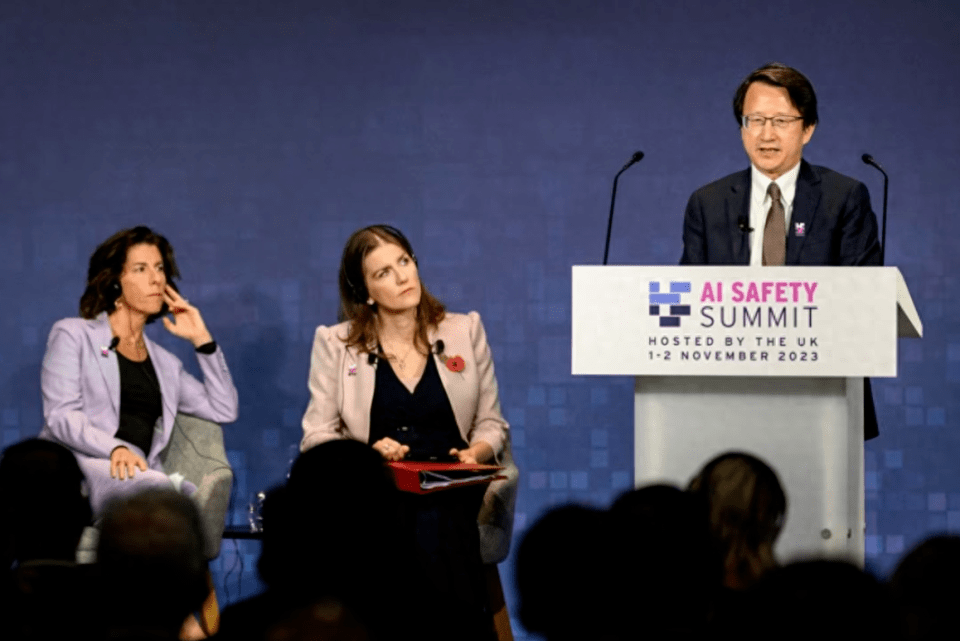 Technology peripherals
Technology peripherals
 AI
AI
 25 countries including China, the United States and Europe signed a declaration agreeing to establish AI regulatory methods
25 countries including China, the United States and Europe signed a declaration agreeing to establish AI regulatory methods
25 countries including China, the United States and Europe signed a declaration agreeing to establish AI regulatory methods
Not long ago, the U.S. government just tightened the technological blockade against China in the fields of semiconductors and artificial intelligence. However, U.S. allies obviously did not buy it. The rewritten content, which has always been tough on China, read: Chinese Prime Minister Sunak even Chinese technical personnel are strongly invited to participate in the World Artificial Intelligence Security Summit held in the UK recently.
At this summit, 25 countries, including China, the United States and Europe, signed the "Bletchley Declaration" and reached a consensus on establishing a regulatory mechanism for artificial intelligence (AI). In other words, in the future, the United States will no longer have the final say in the field of AI technology, and China will also have a say.

U.S. Secretary of Commerce Raimondo (first from left), Chinese Vice Minister of Science and Technology Wu Zhaohui (first from right)
Wu Zhaohui, Vice Minister of Science and Technology of China, emphasized at this summit that artificial intelligence involves the future and destiny of human development. While strengthening technology risk supervision, we should also narrow the technological gap between developed and developing countries, strengthen multilateral cooperation, and achieve mutual benefit and win-win results
It must be said that China’s statements in specific technical fields still demonstrate the vision and pattern of a great power. Nowadays, China’s participation in science and technology summits mainly in European and American countries is by no means just representing China itself, but representing the vast majority of people. Developing countries speak out.
Highlights China's practice of the global "three major initiatives", and at the same time once again proves to the world that China's development brings opportunities rather than challenges, and is truly committed to building a community with a shared future for mankind, rather than being like some countries. The pursuit of technological hegemony and one-stop dominance

AI
China is a world leader in the field of artificial intelligence. The total number of related patent applications in the past year accounted for more than 40% of the world's total, nearly double that of the United States. Moreover, this advantage is still expanding year by year
China’s leading position in the fields of clean energy and communications, as well as its large number of patents, give China a greater say in this field. In other words, some of China’s industry standards can largely represent world standards
The reason why Britain did not follow the United States and exclude China this time is because it had to recognize a reality - in certain technical fields, it is impossible to do without China, and "decoupling and cutting off links" with China is tantamount to jeopardizing the future. And China has indeed gained the opportunity to negotiate at the table by relying on technological innovation and overtaking in corners, and it also has the qualifications to formulate rules in key technological fields.

Rewritten content: Chinese Prime Minister Sunak
China’s technological breakthrough is another major setback for the United States in its policy of technological blockade against China. The United States' choice to co-sign relevant agreements with China reflects that China indeed has irreplaceable influence in the field of artificial intelligence
In a situation where Europe and the United States also have a need for cooperation with China, if the United States forcibly blocks China's participation for its own selfish interests, it will not only be unable to share Chinese technology, but will also offend Europe and aggravate the division of Atlantic relations. This is obviously unwise for the Biden administration, which is eager to pursue political achievements in order to win votes, so it must still make compromises when it is time to compromise
Since Biden issued export control orders targeting three major fields including semiconductors, the EU has begun to take countermeasures and intends to strengthen economic, trade, investment and technological cooperation with China. To this end, the EU introduced the "EU Chip Bill" and conducted a new round of high-level strategic dialogue with China

EU Trade Official Dombrovskis, Chinese Minister of Commerce Wang Wentao
The reason is very simple. The United States' unilateral suppression of China may also affect its allies. If the EU follows the United States closely, the result will inevitably be a "lose-lose situation for China and Europe." For China, as an industry leader, actively participating in this technology summit is actually part of the implementation of the “One Belt, One Road” initiative.
At the previous International Cooperation Summit Forum, China systematically elaborated on China’s plans around artificial intelligence. At that time, China promised that China would respond to the scientific and technological concerns of developing countries and actively participate in national mechanisms and co-governance systems. Contribute Chinese wisdom to the world.
It can be seen that although China has the right to speak in the field of artificial intelligence, it has not erected technical barriers like the United States. Instead, it has shared its development results with the world, making China and the world win-win. To this end, China has also announced the complete lifting of restrictions on foreign investment in manufacturing in order to more fully integrate and collide technology, capital and competition with other countries around the world, and to continuously strengthen itself in cooperation and competition.

In order to rewrite the content without changing the original meaning, the language needs to be rewritten into Chinese, and the original sentence does not need to appear
Of course, the signing of an agreement between China and many European and American countries does not mean that the latter have completely changed their attitude of containing and guarding against China. Rather than believing that the United States views China’s rise correctly and expecting the EU to have strategic autonomy, it is better to take the initiative In order to rewrite the content without changing the original meaning, the language needs to be rewritten into Chinese. The original sentence and China-Europe relations do not need to appear, and the zero-sum game and the myth of hegemony can be defeated through in-depth communication and interaction.
The above is the detailed content of 25 countries including China, the United States and Europe signed a declaration agreeing to establish AI regulatory methods. For more information, please follow other related articles on the PHP Chinese website!

Hot AI Tools

Undresser.AI Undress
AI-powered app for creating realistic nude photos

AI Clothes Remover
Online AI tool for removing clothes from photos.

Undress AI Tool
Undress images for free

Clothoff.io
AI clothes remover

AI Hentai Generator
Generate AI Hentai for free.

Hot Article

Hot Tools

Notepad++7.3.1
Easy-to-use and free code editor

SublimeText3 Chinese version
Chinese version, very easy to use

Zend Studio 13.0.1
Powerful PHP integrated development environment

Dreamweaver CS6
Visual web development tools

SublimeText3 Mac version
God-level code editing software (SublimeText3)

Hot Topics
 1378
1378
 52
52
 How to implement file sorting by debian readdir
Apr 13, 2025 am 09:06 AM
How to implement file sorting by debian readdir
Apr 13, 2025 am 09:06 AM
In Debian systems, the readdir function is used to read directory contents, but the order in which it returns is not predefined. To sort files in a directory, you need to read all files first, and then sort them using the qsort function. The following code demonstrates how to sort directory files using readdir and qsort in Debian system: #include#include#include#include#include//Custom comparison function, used for qsortintcompare(constvoid*a,constvoid*b){returnstrcmp(*(
 How to set the Debian Apache log level
Apr 13, 2025 am 08:33 AM
How to set the Debian Apache log level
Apr 13, 2025 am 08:33 AM
This article describes how to adjust the logging level of the ApacheWeb server in the Debian system. By modifying the configuration file, you can control the verbose level of log information recorded by Apache. Method 1: Modify the main configuration file to locate the configuration file: The configuration file of Apache2.x is usually located in the /etc/apache2/ directory. The file name may be apache2.conf or httpd.conf, depending on your installation method. Edit configuration file: Open configuration file with root permissions using a text editor (such as nano): sudonano/etc/apache2/apache2.conf
 How to optimize the performance of debian readdir
Apr 13, 2025 am 08:48 AM
How to optimize the performance of debian readdir
Apr 13, 2025 am 08:48 AM
In Debian systems, readdir system calls are used to read directory contents. If its performance is not good, try the following optimization strategy: Simplify the number of directory files: Split large directories into multiple small directories as much as possible, reducing the number of items processed per readdir call. Enable directory content caching: build a cache mechanism, update the cache regularly or when directory content changes, and reduce frequent calls to readdir. Memory caches (such as Memcached or Redis) or local caches (such as files or databases) can be considered. Adopt efficient data structure: If you implement directory traversal by yourself, select more efficient data structures (such as hash tables instead of linear search) to store and access directory information
 Debian mail server firewall configuration tips
Apr 13, 2025 am 11:42 AM
Debian mail server firewall configuration tips
Apr 13, 2025 am 11:42 AM
Configuring a Debian mail server's firewall is an important step in ensuring server security. The following are several commonly used firewall configuration methods, including the use of iptables and firewalld. Use iptables to configure firewall to install iptables (if not already installed): sudoapt-getupdatesudoapt-getinstalliptablesView current iptables rules: sudoiptables-L configuration
 Debian mail server SSL certificate installation method
Apr 13, 2025 am 11:39 AM
Debian mail server SSL certificate installation method
Apr 13, 2025 am 11:39 AM
The steps to install an SSL certificate on the Debian mail server are as follows: 1. Install the OpenSSL toolkit First, make sure that the OpenSSL toolkit is already installed on your system. If not installed, you can use the following command to install: sudoapt-getupdatesudoapt-getinstallopenssl2. Generate private key and certificate request Next, use OpenSSL to generate a 2048-bit RSA private key and a certificate request (CSR): openss
 How debian readdir integrates with other tools
Apr 13, 2025 am 09:42 AM
How debian readdir integrates with other tools
Apr 13, 2025 am 09:42 AM
The readdir function in the Debian system is a system call used to read directory contents and is often used in C programming. This article will explain how to integrate readdir with other tools to enhance its functionality. Method 1: Combining C language program and pipeline First, write a C program to call the readdir function and output the result: #include#include#include#includeintmain(intargc,char*argv[]){DIR*dir;structdirent*entry;if(argc!=2){
 How Debian OpenSSL prevents man-in-the-middle attacks
Apr 13, 2025 am 10:30 AM
How Debian OpenSSL prevents man-in-the-middle attacks
Apr 13, 2025 am 10:30 AM
In Debian systems, OpenSSL is an important library for encryption, decryption and certificate management. To prevent a man-in-the-middle attack (MITM), the following measures can be taken: Use HTTPS: Ensure that all network requests use the HTTPS protocol instead of HTTP. HTTPS uses TLS (Transport Layer Security Protocol) to encrypt communication data to ensure that the data is not stolen or tampered during transmission. Verify server certificate: Manually verify the server certificate on the client to ensure it is trustworthy. The server can be manually verified through the delegate method of URLSession
 How to learn Debian syslog
Apr 13, 2025 am 11:51 AM
How to learn Debian syslog
Apr 13, 2025 am 11:51 AM
This guide will guide you to learn how to use Syslog in Debian systems. Syslog is a key service in Linux systems for logging system and application log messages. It helps administrators monitor and analyze system activity to quickly identify and resolve problems. 1. Basic knowledge of Syslog The core functions of Syslog include: centrally collecting and managing log messages; supporting multiple log output formats and target locations (such as files or networks); providing real-time log viewing and filtering functions. 2. Install and configure Syslog (using Rsyslog) The Debian system uses Rsyslog by default. You can install it with the following command: sudoaptupdatesud



